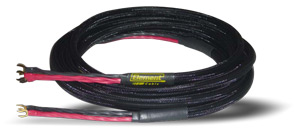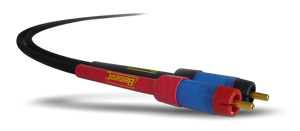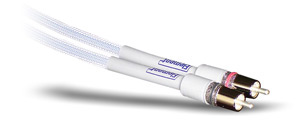
Double Run

Musical II

Silver Serenade
|
Element Cable Double Run Speaker
Cable and Musical II and Silver Serenade Interconnects
Buying things used to be a lot harder. You had to leave the
house, mingle with the public, and, ultimately, deal with salespeople whose motives were
occasionally suspect. One advantage was that you could hold an item in your hands, and
heft it to get a tactile sense of what you were about to purchase. You might even get to
try it out in the store. But returning electronics has always been dicey, often
inconvenient and difficult, or awkward, at best.
Element Cables is a fairly young company that sells its
products exclusively via the Internet. Their business model is to make affordable,
high-quality speaker wire, audio and video interconnects, and power cords for discerning
customers. Audio and video cables are like anything else: you can spend as much or as
little as you want. Getting as much as possible for as little as possible, however, is the
trick. Element strives to offer maximum value, and backs up their work with an
unconditional 30-day, money-back guarantee.
Description
My introduction to conventional high-end audio thinking was
corroded by one thing: lamp cord. The guy stated it emphatically, as if he were
clueing me in to a couldn’t-miss stock tip. He said it with the certainty of
experience and the casual dismissal of a man who refused to be taken in by claims dreamed
up by marketing departments. I worked with this man -- a self-professed audiophile --
years ago in a record store. I never saw him after I left the store, but I never
questioned his wisdom. In my first apartment, I ran brown lamp cord from my receiver to my
speakers because it matched the carpet. In my second apartment, I used lamp cord that at
least looked like speaker wire. When I married and moved in with my new wife, she
wanted the speaker wire to blend into the walls. I bought white lamp cord.
"What are those?" was the reaction I got from her
when the Element Cable Double Run Speaker Cable ($119 USD per 6’ pair) snaked and
unfurled out of the box. The Double Run’s standard length is 6’, but because I
prefer to spread my speakers out and have gotten used to the options offered by a little
extra length, I requested a 9’ pair ($10 per additional foot). The 10AWG cabled
strands of copper wire are thick yet flexible in their black polyethylene insulation. For
someone used to lamp cord, this speaker wire looks more like something you’d see
attached to the belt of a climber dangling off the edge of a cliff. Suddenly, my speaker
wire looked pathetic and disgustingly flimsy. And old. Years of exposing the bare wire
ends to the air had turned the fresh copper color almost black. I asked that the Double
Runs be terminated with banana plugs (spades are the other choice), which are very
convenient, particularly if you plan to disconnect and reconnect with any frequency. But
be warned: neither banana plugs nor spades will fit receivers or speakers with terminals
that are designed to be levered open, then to pinch bare wires.
My confidence in the red-and-white interconnects that come
with the majority of electronics has never been as high as my trust in lamp cord. When I
bought my first CD player in the late 1980s, the consensus was that you needed a good set
of cables to deliver all that information to your amp. Or maybe the salesman just wanted
to upsell me. In any event, I bought a set of bottom-of-the-line Monster interconnects,
which had quaint little arrows on stickers wrapped around one end of each of the cords to
indicate which direction the sound should travel (why not?), and have used them ever
since.
Element interconnects follow the philosophy of cable expert
Jon Risch, whose research and findings are extensively laid out on his website. Risch offers an
interesting and compelling -- though pretty technical -- argument in favor of the benefits
of high-quality (rather than high-priced) cables. Element’s Musical II interconnect
($59 per 2’ pair, $5 for each additional foot) are built from a combination of
high-purity copper-center conductor, foam Teflon insulation, and a braided shield of bare
copper, and are terminated using WBT silver solder. The outer jacket is Teflon, and the
capacitance is rated at 17.3pF/ft, which Element claims is half the capacitance of other
common interconnects.
Risch may understand what that means. To the eye, the
Musical IIs are black and textured, a little thinner than one would expect (about as big
around as an extra-wide straw), bendable but a bit more rigid than anticipated, and
finished at the ends with Eichmann Bullet Plugs, one set red, the other black. The Bullet
Plug is reputed to be the hottest connector on the market, and regarded by many as a
first-rate-sounding connector. I can report that the connection the Bullet Plug makes to a
socket is so tight that when, in my innocence, I tried to connect my DVD player to
my integrated amp, the Musical IIs wouldn’t attach. I panicked for a minute, then
tried it again; with a little twist, the Plugs slid in securely.
Also under consideration are the upgrade from the Musical
II interconnect, the Silver Serenade ($119 USD per 2’ pair). Element says the Silver
Serenade has 99.99%-pure silver conductors and Cardas SLVR plugs, a Teflon dielectric, and
employs cross-spiral geometry suspended in a flexible PE air tube. The Silver Serenades
are unshielded and not recommended for use in areas where a high amount of interference is
present; an upgrade to Eichmann Silver Bullet connectors is available. Beautifully named
and visually stunning, the Silver Serenade appears to be translucent, sometimes off-white
or a faint blue, depending on how it catches the light. They were a touch thicker and more
flexible than the Musical IIs, and I was relieved when their Cardas plugs slid right into
my components’ sockets without incident.
Setup
As I’ve traded up and tried out different speakers
over the years, and moved from one amplifier to the next, my speaker wires and
interconnects have remained constant. I suppose I have inadvertently controlled my
experiments in listening by isolating any changes in sound independent of the cabling.
I’ve been quite satisfied with my system for the last couple of years: a Pioneer
DV-353 DVD player that sounds great and has never failed to play any format of disc
I’ve put in it, the reliable-as-an-old-overcoat NAD C320BEE integrated amp, and the
slightly bright, revealing, and unforgiving German-made MB Quart QLC 204 loudspeakers. The
time was right to think about the fourth, under-recognized component that joins the other
three together, and the only way to do this was to listen to a CD using my baseline set of
Monster interconnects and lamp cord, then systematically switch out the cables one set at
a time and listen again (and switch and listen again, and again).
Sound
Depending on your opinion of The Who, The Kids Are
Alright [CD, PolyGram International 2345] is a bag of gems or an uneven mishmash of
hits and misses. The entire compilation, however, stands on the twin pillars of "Baba
O’Reilly" and "Won’t Get Fooled Again," recorded live at
Shepperton Film Studios in 1979, late in the original lineup’s career. Listening to
these performances, in particular through the Musical IIs, made the Monster interconnects
sound slightly recessed and two-dimensional. The Musical IIs had a better grip on John
Entwistle’s self-contained chaotic bass guitar, and Pete Townshend’s vocal break
on "Baba" had a chilling, exciting presence.
Acting quickly, I disconnected the lamp cord and
substituted the Double Runs. The buzz of the taped keyboard loop at the start of
"Fooled" is an ominous sign of dynamic power, and the new speaker cable conveyed
all of its electricity. This was Keith Moon’s last performance in front of an
audience, and the combination of Musical IIs and Double Runs reproduced his madly perfect
drumming in all its transient speed and charismatic authority. Listening to
"Fooled" again after switching out the Musical IIs for the Silver Serenades, the
recording was slightly more detailed and colorful overall, and never more so than when
reproducing Roger Daltrey’s iconic scream, which gripped my spinal cord and
didn’t want to let go.
Chris Whitley plays four instruments on Dirt Floor
[CD, Messenger 4]: banjo, National Steel guitar, his own voice, and the floorboards. The
album is barely 29 minutes long, and its length, richness, and listenability make it
perfectly suited for repeated plays. I reconnected the Monster interconnects and the lamp
cord, and while producer Craig Street recorded Whitley wonderfully unadorned in a spartan
Vermont cabin, my reference cables presented the performance rather vaguely and
insubstantially, as if Whitley were behind a thin door rather than right there in the
room. With the Musical IIs, Whitley’s shifts, on "Indian Summer," from high
falsetto to reassuring baritone to anxious tenor were tightly defined and delineated. With
a switch from lamp cord to the Double Runs, the stomp of "Scrapyard Lullaby" was
believably realistic, and the wistful mood of Whitley’s National Steel and gentle
vocal was liquidy and soothingly reassuring. Back to "Indian Summer" through a
Silver Serenade/Double Run combo, the track retained all its bluesy relentlessness, but
gained in airiness and clarity as Whitley’s slide squeaked up and down the neck of
his instrument.
There is hardly a more commanding voice in jazz than
Hamiett Bluiett’s baritone saxophone, and there isn’t a more accessible and
inspired setting for showing off Bluiett’s multiple personalities than Young
Warrior, Old Warrior [CD, Mapleshade 2932], a 1995 recording that puts Bluiett
somewhere in the middle of a sextet whose players’ ages span 50 years. The band sound
is startlingly huge, but its full effect couldn’t be appreciated until I played the
CD through once again with the Musical II/Double Run pairing. Whereas on the opening cut,
"Blue ’N’ Boogie," the band had previously sounded cropped and
boxed-in, it was now expansive and tonally overflowing. Tenor Mark Shim holds his own
until Bluiett makes his entrance, and the Element cables rendered the leader’s regal
tone with bracing authority.
After that impressive and arresting display from the
Musical IIs, I decided to compare the Musical IIs head to head with the Silver Serenades,
the former having proven themselves clearly superior to the Monsters, but with the
indisputable superiority of the latter still uncertain. Both would be matched with the
Double Run speaker cables, which, early on, had consigned my lamp cord to tying up bags of
leaves. Richard Thompson’s 1991 album, Rumour and Sigh [CD, Capitol CDP 95731
2], marks the moment when the artificial production values of the 1980s began to be scaled
back in favor of a more earthbound sound while retaining some studio seasoning. Through
the Musical IIs, the drums on "Grey Walls" snapped, and Thompson’s vocals
on "Why Must I Plead" had just the right amount of grain and darkly tinged soul.
The centerpiece of the CD, however, is "1952 Vincent Black Lightning," a story
song you might hear in any English pub whose clientele includes at least one master
musician. As expected, the speaker cables established a solid soundstage to form the
recording’s foundation, while the Musical IIs were as nimble as Thompson’s
fingerwork and reproduced the dynamic nuances of the singer’s voice as he told his
tale. That same vocal through the Silver Serenades, however, was ever so slightly more
front-and-center and crystalline, while the guitar took on just a tad more dimensionality.
Conclusion
My former attitude toward cables was like that of a kid who
watches television in a library: I was being sufficiently entertained by my system and was
completely satisfied, but had the feeling that, all around me, something richer waited to
be tapped. The sound quality my lamp cord was able to reproduce was, I now see,
embarrassing. The Element Double Run speaker cable added fullness, realism, and a
geometric thickness that the lamp cord simply wasn’t capable of. By increasing the
amount of musical information they were able to retrieve, the Element Cable Musical II
interconnects bested my reference Monster interconnects without adding any noticeable
sound of their own. The Silver Serenades, in comparison, were incrementally more
transparent and linear, but wonderful to handle and look at.
If you’re happy with the components you have, consider
the expense of high-quality cables such as those from Element to be the final step that
moves your trio of player, amplifier, and speakers into four-part harmony.
...Jeff Stockton
Prices of equipment reviewed
|